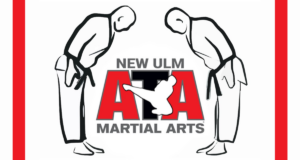Classes at New Ulm ATA Martial Arts include
Social Skills Lessons & Physical Training
Bowing In & Oath Recitation
At the beginning of every class, the instructor will bow in the students. This includes bowing to the instructor(s), the flags, and to the parents in attendance.
*Tiger Oath: ” I promise to be a good person, with knowledge in my mind, honesty in my heart, strength in my body, to make good friends. And if I continue to do this, I will become a black belt, Sir!”
*Youth/Adults Oath (before class): “Sir, I will practice in the Spirit of Taekwondo, with Courtesy for fellow students, Loyalty for my instructor, and respect for my juniors and seniors, Sir!”
Warm-up and Stretching
Light warm-ups and stretching prepare the muscles and joints for the workout they’re about to get.
Social Skills Lessons
During the stretching phase, the instructor talks through the lesson of the day. The ATA has a series of lessons that rotate on a cycle. Those lessons cover the topics of HONESTY, RESPECT, DISCIPLINE, COMMUNICATION, SELF ESTEEM, and BELIEF.
Drills
Students will be led through a series of drills that work on kicks, punches, blocks, and stances fitting their belt levels. These drills transition from warm-up activities to higher intensity movements. It’s an opportunity to focus on the details of how each specific move is properly executed so they are deployed properly in other areas like forms. These drills are performed in a variety of manners individually, with a partner, “in the air,” and against padded targets.
Forms
Forms are a series of moves fitting the student’s belt level and in a specific sequence. It’s an opportunity to show your ability to perform the moves taught up to your level. Successfully executing your belt level’s form is one of the requirements for belt rank promotion. Traditional Forms are open hand (no weapons) techniques. Weapons Forms are also choreographed moves in a particular sequence, but they include the use of a variety of weapon types.
Sparring
There are a few different types of sparring a student will learn. One-Step sparring is the introduction to sparring. These are choreographed steps to simulate the offensive and defensive sides of sparring. It is no contact and used from White through Yellow belts. Traditional Sparring is likely what you’re most familiar with seeing. It’s generally one-on-one and involves improvised attack and defend moves. It teaches students to act and react using the moves they know to their current level. It is part of the testing requirement for belt and rank promotions starting at the Camouflage belt rank. Combat sparring is a more advanced sparring technique using a Bahng Mahng EE (a padded 2ft baton).
Board Breaking
The breaking of boards is also one of the testing requirements for testing to the next belt rank. Breaking boards demonstrates the student’s ability to show force with the moves learned without risk of injuring an opponent. It also has the ability to show the student how powerful those strikes can be and that they are not something to be “played” with for fun.
Self Defense
Although learning to block, kick, and punch is self defense training in itself, there are other less devastating tactics that can be deployed in many instances. Learning to use things like joint manipulations and pressure points to break free from a choke or hold provides ways to break free from an aggressor without having to utilize kicks or punches. This is effective with anti-bullying techniques by teaching a student to safely break free without getting into an actual fight.
Lesson Recap, Oath Recitation, and Bowing Out
Each class ends with a cool down routine where the instructor recaps the day’s social skills lesson.
*Tiger Oath (same as before class): ” I promise to be a good person, with knowledge in my mind, honesty in my heart, strength in my body, to make good friends. And if I continue to do this, I will become a black belt, Sir!”
*Youth/Adults Oath (after class): “Sir, I shall live with Perseverance in the Spirit of Taekwondo, having Honor with others, Integrity within myself, and Self Control in my actions, Sir!”
The students are bowed out in similar fashion to the bow-in noted above. The instructor then releases the class while assigning them a simple goal/reminder related to the day’s lesson.

